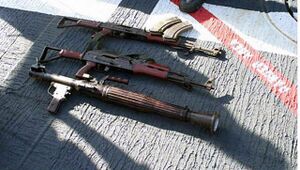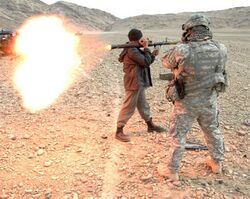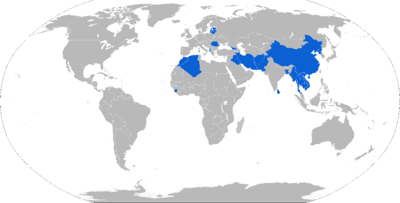Engineering:Type 69 RPG
| Norinco Type 69 RPG | |
|---|---|
 A Type 69 RPG and a pair of Type 56-2 assault rifles. | |
| Type | Anti-tank, anti-personnel, rocket-propelled grenade |
| Place of origin | China |
| Service history | |
| In service | 1970–present |
| Used by | See Operators |
| Wars | Mozambican War of Independence Sino-Vietnamese War Soviet war in Afghanistan Iran–Iraq War Sri Lankan Civil War Somali Civil War War in North-West Pakistan Iraq War 2008 Cambodian-Thai stand-off Kivu conflict[1] Boko Haram insurgency Syrian civil war |
| Production history | |
| Designer | Norinco |
| Designed | 1970 |
| Manufacturer | Norinco |
| Produced | 1970–present |
| Variants | Type 69-I |
| Specifications | |
| Mass | 5.6 kg (12.3 lb) |
| Length | 910 mm (35.8 in) |
| Crew | 1 or 2, depending on situation |
| Cartridge | 40 mm (1.57") barrel 85mm warhead |
| Effective firing range | 200 m (656 ft) |
| Maximum firing range | 600 m (1,968 ft) |
| Feed system | one round per shot |
| Sights | Iron sights. Infrared and night vision sights possible |
The Type 69 85mm rocket propelled grenade (RPG), made by Norinco, is a Chinese variant of the Soviet RPG-7. First introduced in 1972[2], the Type 69 is a common individual anti-tank weapon in service with the PLA. More advanced grenade rounds were developed in the 1980s and 1990s to meet the requirements of modern battlefields. Eventually, the aging Type 69 RPG family was replaced by modern anti-tank weapon systems developed by China such as Type 89 and Type 08.
Origin
History
China first obtained the RPG-2 85mm anti-tank RPG in the early 1950s, and began to build Chinese copies in 1956 under the designation Type 56.[3] However, the rapid development of the new generation main battle tanks (MBTs) in the early 1960s posed new threats to the PLA, which was later proven in the 1969 Sino-Soviet border conflict. Because the Type 56 was unable to penetrate the armour of the new generation Soviet tanks such as the T-62, the PLA desperately needed a new individual anti-tank weapon to replace the aging Type 56.[2]
Reverse-engineering of the RPG-7 began in the early 1960s, and demonstrations were made to senior PLA officials in 1964. The Chinese copy of the RPG-7, designated Type 69, received its design certificate in 1970. The weapon entered service with the PLA in the mid-1970s, and took part in the 1979 Sino-Vietnam border conflict to provide platoon-level anti-personnel and anti-obstacle fire support. Its performance was highly praised by the troops.[2]
As well as being equipped by the PLA, the Type 69 has also been exported in significant numbers to many foreign customers, including the Mujahideen in Afghanistan under the covert co-operations between China and the CIA in the 1980s against the Soviet Union.[4]
Status
The production of the Type 69 RPG stopped in the mid-1980s when an advanced version, Type 69-I was introduced by Norinco. As the weapon became less effective in modern land battlefield, the Type 69 RPG is being gradually replaced by the PF-89 80mm anti-tank grenade launcher.[5]
RPG rounds
Although the design of the grenade launcher has not changed significantly since it was introduced nearly thirty years ago, many new types of grenade rounds have been developed over the years to provide enhanced capabilities, including:[6]
Type 69 high-explosive anti-tank (HEAT): basic grenade introduced in the PLA during the 1970s with the Type 69. Phased out of PLA service.
Type 69-I hollow charge high-explosive anti-tank: standard HEAT grenade developed for the PLA in the 1980s. The hollow warhead was created with improved armour-piercing capabilities.
Type 69-II HEAT: the same as the Type 69-I HEAT grenade, except that it is improved to defeat modern armoured vehicles that are equipped with anti-tank missile plating.
Type 69-III HEAT: the same as the Type 69-II, increased range and further improved armour-piercing abilities.
Type 84 HEAT: made in the 1980s as a lighter warhead with the ability to be fired from long range with claims that the rocket is not affected by side winds. Usable with both Type 69 and 69-I rocket launchers.
Type 69 75mm airburst anti-personnel high-explosive (HE): created for anti-personnel purposes. This is mostly meant to combat against entrenched forces since the rocket, after gaining impact on the ground, bounces to a height of around 2m then airbursts over the target area, scattering about 800 anti-personnel steel balls over a lethal radius of 15m.
HE/HEAT: used for anti-armour and anti-personnel combat. Even though it has 1,500 prefabricated fragments which scatter over a 20m radius on detonation, the rocket retains its anti-tank capabilities.
Anti-personnel high-explosive incendiary (HEI): created for use in certain environments such as jungles and mountains, it has 900 steel balls and 2,000 to 3,000 incendiary pellets that scatter over a 15m radius on detonation.
Tandem-warhead anti-tank grenade: thought to have been used in the 1990s, it is meant to penetrate vehicles with explosive reaction armour or ERA. Even though it can not defeat most modern vehicles, lighter vehicles such as APCs and AFVs can be destroyed with this rocket.
Illumination grenade: equipped with a small parachute to suspend it in mid air while being used, its effective range is 600m with the braking ring and 1,500m without it.
Operators
 Afghanistan[4]
Afghanistan[4] Albania[citation needed]
Albania[citation needed] Algeria[citation needed]
Algeria[citation needed] Bangladesh: 200[7]
Bangladesh: 200[7] Burundi[8]
Burundi[8] Cambodia[citation needed]
Cambodia[citation needed] Chile: Type 69s were used by the Chilean army in 1978, not in current use
Chile: Type 69s were used by the Chilean army in 1978, not in current use Central African Republic[9]
Central African Republic[9] China
China Congo-Kinshasa[10]
Congo-Kinshasa[10]
 Democratic Forces for the Liberation of Rwanda[1]
Democratic Forces for the Liberation of Rwanda[1]
 Estonia: Type 69s are old stocks remaining, not in current use[11]
Estonia: Type 69s are old stocks remaining, not in current use[11] Georgia[citation needed]
Georgia[citation needed] Iran[12]
Iran[12] Iraq[12]
Iraq[12] Latvia[citation needed]
Latvia[citation needed] Lithuania[citation needed]
Lithuania[citation needed] Laos[citation needed]
Laos[citation needed] Malta: Armed Forces of Malta
Malta: Armed Forces of Malta Morocco[citation needed]
Morocco[citation needed] Mozambique: supplied to FRELIMO during the Independence War[13]
Mozambique: supplied to FRELIMO during the Independence War[13] Myanmar[citation needed]
Myanmar[citation needed] Niger[14]
Niger[14] North Korea[citation needed]
North Korea[citation needed] Pakistan: used by the Pakistan Army and Paramilitary forces of Pakistan.[15][16]
Pakistan: used by the Pakistan Army and Paramilitary forces of Pakistan.[15][16] Romania[citation needed]
Romania[citation needed] Sierra Leone[citation needed]
Sierra Leone[citation needed] Somalia
Somalia
 Hizbul Islam[2]
Hizbul Islam[2]
 South Sudan: South Sudan Democratic Movement[17]
South Sudan: South Sudan Democratic Movement[17] Soviet Union Spetsnaz were equipped with captured Type 69s in Afghanistan[4]
Soviet Union Spetsnaz were equipped with captured Type 69s in Afghanistan[4] Sri Lanka[citation needed]
Sri Lanka[citation needed] Zimbabwe[18][19]
Zimbabwe[18][19]
See also
- Yasin
- Bazalt - Russian manufacturer of the RPG-7 & RPG-29
- PF-89 and DZJ-08 next generation man-portable rocket launcher and recoilless gun developed by China, successing Type 69.
Notes
- Rottman, Gordon L. (2010). The Rocket Propelled Grenade. Weapon 2. Osprey Publishing. ISBN 978-1-84908-153-5. https://books.google.fr/books?id=NDa1CwAAQBAJ.
- ↑ Jump up to: 1.0 1.1 Small Arms Survey (2015). "Waning Cohesion: The Rise and Fall of the FDLR–FOCA". Small Arms Survey 2015: weapons and the world. Cambridge University Press. p. 202. http://www.smallarmssurvey.org/fileadmin/docs/A-Yearbook/2015/eng/Small-Arms-Survey-2015-Chapter-07-EN.pdf.
- ↑ Jump up to: 2.0 2.1 2.2 2.3 Rottman 2010, p. 36.
- ↑ Rottman 2010, p. 19.
- ↑ Jump up to: 4.0 4.1 4.2 Rottman 2010, p. 64.
- ↑ Rottman 2010, p. 37.
- ↑ Type 69 Grenade Variants Retrieved on March 18, 2007.
- ↑ Small Arms Survey (2011). "Larger but Less Known: Authorized Light Weapons Transfers". Small Arms Survey 2011: States of Security. Oxford University Press. p. 29. http://www.smallarmssurvey.org/fileadmin/docs/A-Yearbook/2011/en/Small-Arms-Survey-2011-Chapter-01-EN.pdf.
- ↑ Reuters (2016-02-22). "UN Under Pressure to Show It Can Help End Burundi Violence". VOA News. https://www.voanews.com/a/united-nations-burundi-violence/3201333.html. Retrieved 2017-06-25.
- ↑ Berman, Eric G.; Lombard, Louisa N. (December 2008). The Central African Republic and Small Arms: A Regional Tinderbox. Small Arms Survey. pp. 82, 94. ISBN 2-8288-0103-9. http://www.smallarmssurvey.org/fileadmin/docs/D-Book-series/book-07-CAR/SAS-Central-African-Republic-and-Small-Arms.pdf.
- ↑ http://worldmilitaryintel.blogspot.com/2013/05/blog-post_6381.html
- ↑ "Tehnika - Granaadiheitja M-69" (in et). http://www.mil.ee/?menu=tehnika1&sisu=m69.
- ↑ Jump up to: 12.0 12.1 Rottman 2010, p. 38.
- ↑ Abbott, Peter (2005). Modern African Wars (2): Angola and Mozambique 1961–1974. Oxford: Osprey Publishing. p. 15. ISBN 978-0-85045-843-5.
- ↑ Savannah de Tessières (January 2018) (in en). At the Crossroads of Sahelian Conflicts: Insecurity, Terrorism, and Arms Trafficking in Niger (Report). Small Arms Survey. p. 24. ISBN 978-2-940548-48-4. http://www.smallarmssurvey.org/fileadmin/docs/U-Reports/SAS-SANA-Report-Niger.pdf.
- ↑ "Air Burst Anti Personnel Rocket Calibre 40 mm RGP-7AP". Archived from the original on 2013-08-24. https://web.archive.org/web/20130824192202/http://pof.gov.pk/ROC_AirBurstCalibre40mmRPG7AP.aspx.
- ↑ "40 MM Heat P1 MK1 (RPG-7P)". Archived from the original on 2012-12-08. https://web.archive.org/web/20121208083012/http://www.pof.gov.pk/ROC_40MMHEATP1MK1RPG79.aspx.
- ↑ Small Arms Survey (2014). "Weapons tracing in Sudan and South Sudan". Small Arms Survey 2014: Women and guns. Cambridge University Press. pp. 227. http://www.smallarmssurvey.org/fileadmin/docs/A-Yearbook/2014/en/Small-Arms-Survey-2014-Chapter-7-EN.pdf.
- ↑ Keegan, John (1983). World Armies (Second ed.). Basingstoke: Palgrave-Macmillan. p. 488. ISBN 978-0333340790.
- ↑ Hussein, Solomon (1988). Towards a Common Defence and Security Policy in the Southern African Development Community. Pretoria: Africa Institute of South Africa. pp. 109-111. ISBN 978-0798301749.
External links



